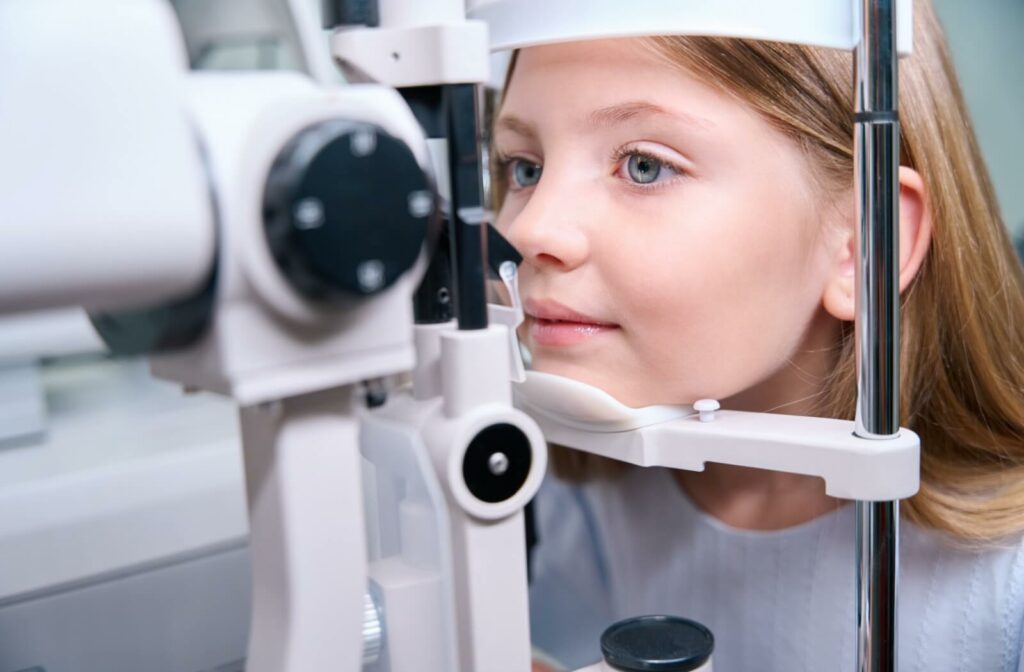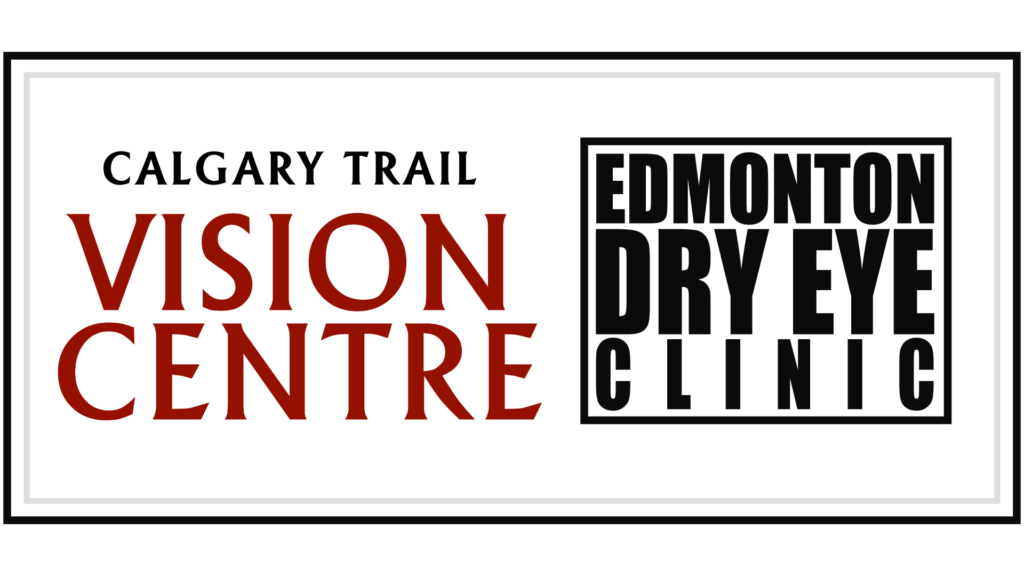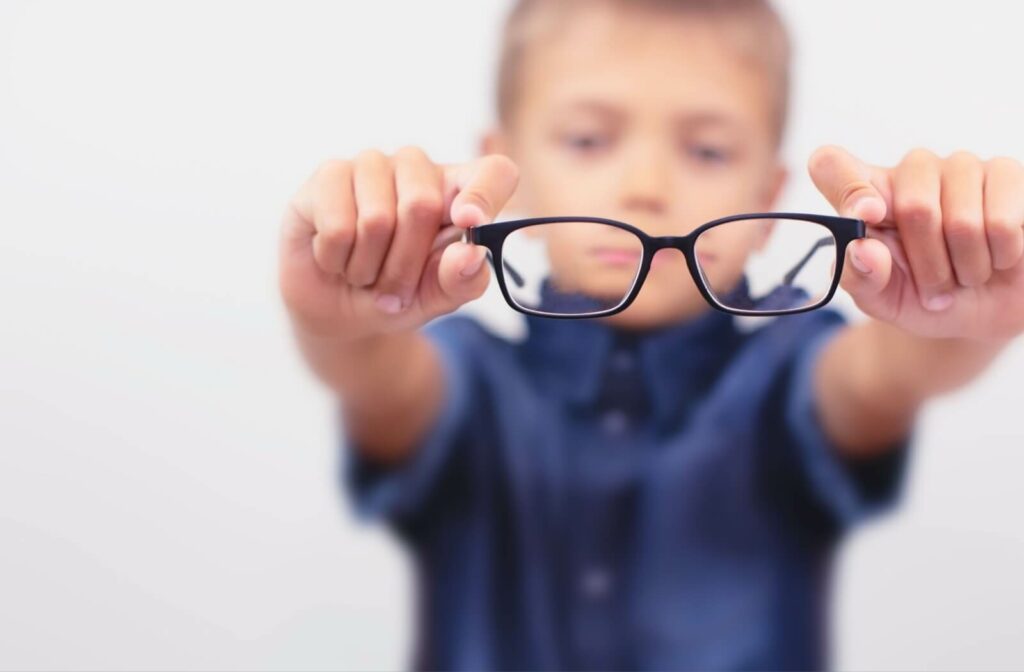As screen time increases and outdoor play time decreases, myopia is becoming a more frequent concern for children. Myopia, also called nearsightedness, causes distant objects to appear blurry and can progress over time if not managed properly.
While myopia can’t be reversed, it can be managed through a personalized plan that may involve special lenses, contact lenses, eye drops, and lifestyle changes.
What Is Myopia?
Myopia is a refractive error that occurs when the eye grows too long or the cornea becomes too curved. This causes light to focus in front of the retina instead of directly on it, resulting in blurred distance vision. It often begins in childhood and tends to worsen as the eyes develop.
Myopia can affect a person’s ability to see the board at school, play sports, or even read signs while walking or driving. Children aren’t always able to express that they’re struggling to see clearly, so regular children’s eye exams are important.
Some common signs of myopia include:
- Blurry distance vision
- Squinting
- Frequent headaches
- Eye fatigue
- Complaints about not being able to see the board or TV clearly
When Does Myopia Progress the Most?
Myopia typically progresses most rapidly between ages 6 and 12, when the eyes are still developing. During these years, vision changes can occur quickly and quietly. That’s why early detection and consistent eye exams are essential in helping slow progression.
By identifying signs of myopia early, families can work with their optometrist to begin proactive care and reduce the risk of significant vision challenges later in life.
Can Myopia Be Cured?
Myopia can’t be cured, but its progression can be slowed. The goal of myopia management is to correct vision and reduce the rate at which myopia progresses, thereby reducing future risk of eye health issues, such as retinal detachment, glaucoma, or cataracts, that are more common in people with high myopia.
Managing myopia early and consistently helps protect long-term visual health.
What Are the Options for Managing Myopia?

There’s no single solution for myopia. Instead, management involves a combination of approaches, including specialized lenses, contact lenses, low-dose atropine eye drops, and adjustments to daily habits. A personalized plan can be built based on your age, prescription, and comfort with different treatments.
Prescription Lenses for Myopia Control
While standard glasses correct blurry distance vision, myopia control lenses are designed to help slow the progression of myopia. Some common glasses options include:
These lenses incorporate treatment zones that help manage the eye’s growth patterns, slowing the rate at which it grows longer and slowing the progression of myopia.
Contact lenses are another option, particularly for active children or teens who prefer not to wear glasses. Some commonly recommended contact lens choices include:
Orthokeratology (Ortho-K)
Ortho-k lenses are custom-fitted and worn overnight to gently reshape the cornea. They provide clear vision during the day without the need for glasses or contacts. This method has shown encouraging results in slowing axial eye growth, making it a strong option for managing childhood myopia.
Low-Dose Atropine Eye Drops
Low-dose atropine is typically used before bed and can be effective in reducing how quickly myopia progresses. It can be combined with other strategies such as specialty glasses or contact lenses.
We can help you determine if atropine is a good fit for your child’s needs and overall treatment plan.
Lifestyle Adjustments
Simple, consistent habits at home can support long-term results. These include:
- Spending more time outdoors: Daily exposure to natural light has been linked to a lower risk of myopia. Aim for at least 2 hours per day outdoors when possible.
- Reducing near work strain: Long periods of reading or screen use can increase the risk of eye fatigue. Encourage regular breaks, using the 20-20-20 rule: every 20 minutes, look at something 20 feet away for 20 seconds.
- Supporting eye health with nutrition: Omega-3 fatty acids, leafy greens, and colourful fruits provide antioxidants that help protect the eyes from oxidative stress.
The Role of Regular Eye Exams
Comprehensive eye exams are the foundation of any myopia management plan. Routine checkups allow your optometrist to monitor prescription changes, assess eye health, and make timely adjustments to treatment. Early detection, especially during childhood, can help slow myopia progression and protect long-term vision.
At Calgary Trail Vision Centre, we provide personalized eye care that includes myopia management options for people of all ages. We use modern technology to monitor progression and recommend solutions backed by research and clinical experience.
Why Long-Term Monitoring Matters
Myopia is not a one-time diagnosis; it’s a condition that evolves. That’s why regular eye exams and long-term care matter. At Calgary Trail Vision Centre, we use modern diagnostic tools to track how the eye is changing and adjust treatment as needed.
Our approach combines personalized care with modern tools to monitor eye changes and adjust treatment as needed. Whether we’re helping your child start their first treatment or guiding your family through preventive options, we’re here to provide clarity and confidence in your care.
If you’re concerned about your child’s vision or want to explore options for managing your own myopia, book an eye exam today.


